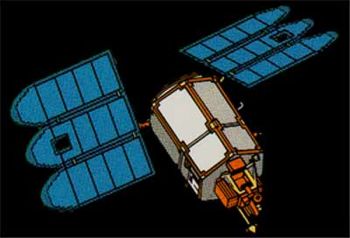
Home - Search - Browse - Alphabetic Index: 0- 1- 2- 3- 4- 5- 6- 7- 8- 9
A- B- C- D- E- F- G- H- I- J- K- L- M- N- O- P- Q- R- S- T- U- V- W- X- Y- Z
TOMS-EP
 TOMS-EP Credit: Manufacturer Image |
AKA: Total Ozone Mapping Spectrometer - Earth Probe. Status: Operational 1996. First Launch: 1996-07-02. Last Launch: 1996-07-02. Number: 1 . Gross mass: 248 kg (546 lb). Height: 1.73 m (5.67 ft). Span: 3.90 m (12.70 ft).
TOMS-EP was the third mission in NASA's TOMS program, which provided long-term observations of the global distribution of the Earth's ozone layer and measurements of sulfur-dioxide released in volcanic eruptions.
Previous versions of the spacecraft's TOMS instrument were launched aboard the Nimbus-7 (1978) and Soviet Meteor-3 (1991) satellites. These instruments provided detailed maps of the world's global atmospheric ozone distribution, and observed the Antarctic "ozone hole" which forms September through November of each year. TOMS-EP would add to the data set collected by these missions, and would be followed by other TOMS instruments carried aboard the ADEOS (1996) and Russian Meteor-3M satellite (2000). Originally intended for launch in 1994, TOMS-EP was delayed by the failures of the first two Pegasus XL launch vehicles. As a result of this delay, TOMS-EP was to fly simultaneously with the ADEOS TOMS instrument (originally planned as TOMS-EP's successor).
To prevent the gathering of redundant data sets, TOMS-EP was placed into an orbit lower than originally planned to obtain higher resolution measurements. The two instruments working at different altitudes would enhance data collection by affording a more reliable separation of stratospheric ozone from tropospheric ozone, improving detection of urban pollution and other small-scale features, and allowing comparison of ozone data from cloudy and clear atmospheres. Together, TOMS-EP and ADEOS would provide full daily global coverage of ozone measurements. The TOMS program was part of NASA's Mission to Planet Earth, a long term, coordinated research effort to study the Earth as a global environmental system.
The spacecraft was based on the TRW Eagle family of light weight spacecraft, and was 3-axis stabilized with pointing control to 0.5 deg (3-sigma) in pitch/roll, 1 deg in yaw and knowledge to 0.25 deg (3-sigma). Two solar arrays provided up to 275 W. The hydrazine propulsion system (54 kg fuel) with eight thrusters (0.4 and 1 lbf) was used to raise the orbit and desaturate momentum wheels. Communications were via DSN, GSTDN at downlink rates of 50 and 202 kbps, uplink rates of 2 kbps.16 Mb solid state storage was provided. The satellite was designed for 24 hour autonomous operation.
The TOMS instrument had a mass of 35 kg and 25 watts average power. Resolution was 47 km at nadir and 62 km average. Swath width was 2750 km. TOMS/EP measured total ozone by observing both incoming solar energy and backscattered ultraviolet (UV) radiation at six wavelengths. "Backscattered" radiation was solar radiation that had penetrated to the Earth's lower atmosphere and was then scattered by air molecules and clouds back through the stratosphere to the satellite sensors. TOMS made 35 measurements every 8 seconds, each covering 30 to 125 miles (50 to 200 kilometers) wide on the ground, strung along a line perpendicular to the motion of the satellite.
More at: TOMS-EP.
Family: Atmosphere sat, Earth, Sun synchronous orbit. Country: USA. Launch Vehicles: Pegasus, Taurus, Pegasus XL. Launch Sites: Point Arguello WADZ. Agency: NASA, TRW, Perkin Elmer. Bibliography: 2, 4, 6, 13284.
1996 July 2 - . 07:48 GMT - . Launch Site: Point Arguello. Launch Complex: Point Arguello WADZ. Launch Pad: Aircraft from Vandenberg.. Launch Platform: L-1011. LV Family: Pegasus. Launch Vehicle: Pegasus XL.
- TOMS-EP - . Mass: 248 kg (546 lb). Nation: USA. Agency: NASA Greenbelt. Class: Earth. Type: Atmosphere satellite. Spacecraft Bus: T100. Spacecraft: TOMS-EP. USAF Sat Cat: 23940 . COSPAR: 1996-037A. Apogee: 746 km (463 mi). Perigee: 705 km (438 mi). Inclination: 98.30 deg. Period: 99.30 min. LEO. Total Ozone Mapping Spectrometer-Earth Probe; atmospheric ozone mapping. Air dropped in Point Arguello WADZ..
Back to top of page
Home - Search - Browse - Alphabetic Index: 0- 1- 2- 3- 4- 5- 6- 7- 8- 9
A- B- C- D- E- F- G- H- I- J- K- L- M- N- O- P- Q- R- S- T- U- V- W- X- Y- Z
© 1997-2019 Mark Wade - Contact
© / Conditions for Use